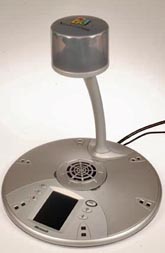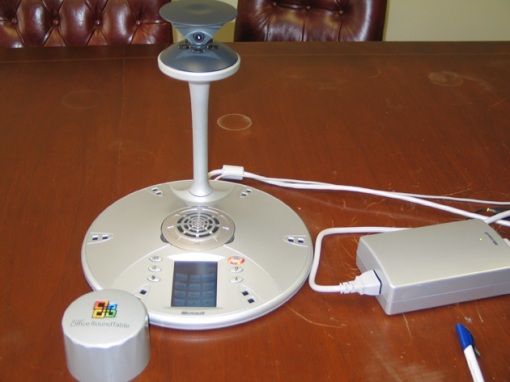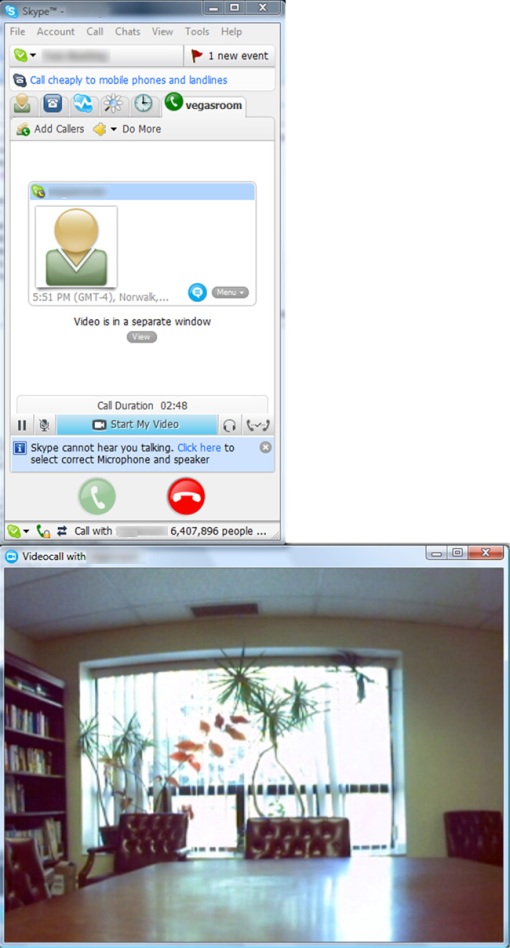
Microsoft RoundTable is a very cool videoconferencing system featuring 360° panoramic views powered by its 5 built-in cameras. Microsoft sent me a RoundTable system for review. I figured I may as well install it in one of TMC’s two conference rooms to have some “real world” testing scenarios. After plugging in the various cables, including a USB cable to the host PC, I then installed the Microsoft Office Live Meeting 2007 (LM 2007) beta software client, which was designed to handle the RoundTable’s 360° panoramic cameras. I should point out that Microsoft is offering both a hosted model for Microsoft Office Live Meeting 2007 as well as a CPE (customer premise equipment) solution, namely Office Communications Server 2007 (OCS 2007). The RoundTable can work with either. However, I tested it with a Microsoft Office Live Meeting online beta account.
The RoundTable actually installs two USB camera devices. The first is the Active Speaker which uses the RoundTable’s 6 microphones to locate where in the room the active speaker is and then focus one of the 5 cameras onto that person. I suspect it may actually use 2 cameras to focus on a person, since it always appears that the speaker is “centered” which probably would require at least 2 camera images and then the images are “spliced” together, processed, and then transmitted over the USB cable. The second USB camera device is the panoramic camera which combines the 5 camera images into a single panoramic image.
Next, I initiated a Live Meeting session in the conference room and went back to my desk to join the meeting. Unbeknownst to me, by the time I got to my desk, some TMC sales team members walked into the conference room to start a meeting. When I launched my LM 2007 client I saw Anthony Graffeo, one of TMC’s sales staff staring right into one of the 5 triangular mirrors located just above the cameras. I headed over the conference room to tell them I could see and hear everything that was going on. After giving a brief demo, Anthony said, “that thing is awesome!”. I heard similar comments from other TMCers over the next few days – including “That thing is cool” and “Wow! What is that?”

During my tests with Office Live Meeting 2007, I was able to see the entire conference room in the panoramic view. The other video view is the “active speaker” and it would change to whoever was speaking. It was actually quite accurate and surprisingly fast. When I tested it with Rich Tehrani, Joe Fabiano, Mike Genaro, and Dave Rodriguez, we all took turns speaking and the camera view would almost instantly switch.
Overall, the video quality was excellent, Very smooth. Later on I did some more tests with just me in the conference room. I tried to trick the cameras by snapping my fingers above the microphone and the video wouldn’t switch. I figured it must be using a combination of audio and video cues to determine the active speaker. A quick glance in the manual reveals, “To avoid switching to a non-human sound source, the video functions to assist in determining whether the sound detected is coming from an attendee or some other source.” Answers that question!
Below is a Flash demo demonstrating the active speaker functionality. When I ran this test, I did it by myself and just walked around the conference room while continuing to speak. I will make a 2nd video with several fellow TMCers if I can get some volunteers. This would better demonstrate the active speaker feature. Also, the video I did record appears much jerkier than it actually was live. Part of that is because it was my first time using Camtasia Studio to capture the screen & audio, so I only had it set to 15fps (not 30fps). Secondly, the PC I was recording on isn’t the greatest, so I’m sure Camtasia skipped a few video frames since it the processor was taxed. Nevertheless, this video gives you a good feel for the active speaker functionality.
he base has an LCD touch-screen that serves as a dialpad and to configure various options. An external dialpad is available as well, but I didn’t get one with my unit, so not sure if that’s an extra option. The LCD touch-screen dialpad seems good enough to me. Physical buttons also exist to increase/decrease speaker volume, a mute audio / halt video button, Flash button, on/off hook, and an Information button. There is also a privacy cap that goes on top of the unit to block the cameras and prevent anyone from viewing the conference room.
Although the Microsoft RoundTable was designed for Office Live Meeting 2007 & OCS 2007, since it is simply 2 separate USB camera devices in the Device Manager, I figured it would most likely work with other videoconferencing, audioconferencing, or VoIP software. So I fired up Skype on the conference room PC and went into the video wizard. I tried the panoramic device first, but all that was displayed was a black screen. Then I changed it to the active speaker USB camera device and it worked. I made a test Skype call to the Microsoft Roundtable, again with some fellow TMC’ers and the active speaker functionality worked just as well in Skype. Obviously, it’s the RoundTable hardware performing the video switching and not LM 2007. Also, I was able to use Skype’s “full screen” video mode and it had extremely high-resolution video with very fast frame rates. Here’s a screenshot of Skype in action viewing the RoundTable video:
Microsoft designed RoundTable to equalize the varying light levels when one part of the conference room is darker than another. In fact, TMC’s conference room has sunlight coming in the window and I noticed the RoundTable was able to do a pretty good job equalizing the light across the entire room.
The Microsoft RoundTable features both an RJ11 (phone) and an RJ45 (network) jack. The RJ11 wire lets you connect to a PSTN line and use the RoundTable as a high-end conference room speakerphone. The RoundTable lets you place outgoing calls, answer an incoming call, conduct a video conference with audio from the microphones or a video-only session with no audio from the microphones. In the video-only mode you can use the PSTN line or even your cell phone for the audio portion.
I like the aesthetic design of the Microsoft RoundTable. It is one cool looking device. Reminds me of the alien spaceships in H.G. Wells’ War of the Worlds movie (the original 1953 movie, not the Tom Cruise remake). Compare for yourself! Both have “eyes” and both have a long neck connected to the main base.
Interestingly, the RoundTable doesn’t aim its 5 cameras directly at you. As previously mentioned, it uses triangular mirrors. I’m not sure if this was done because people are more relaxed and natural if they don’t think a camera is staring right back at them or if it was simply for aesthetic design that Microsoft chose to use mirrors. I did some research on the history of the RoundTable and discovered it was previously called the Ringcam. During Microsoft’s research, they had some interesting “beta” versions before the final RoundTable, including these two below. Note how both models point cameras directly outward. I definitely prefer the less obtrusive “mirror” version in the production model. I tried to take apart the RoundTable to see the inner guts of the camera head, but the damn thing is glued on or something since I couldn’t find any screws.
Even more interesting in a Microsoft Research PDF article it talks about head-size spatial equalization. That is, making sure everyone’s head is equally big in the videoconference even if a person is further from the camera. The article has several diagrams and complex trigonometry formulas (sin & cos functions) that bring back high school. The article states the following:
In the past a few years, there has been a lot of interest in the use of omni-directional cameras for video conferencing and meeting recording. While a panoramic view is capable of capturing every participant’s face, one drawback is that the image sizes of the people around the meeting table are not uniform in size due to the varying distances to the camera. Figure 1 shows a 360 degree panorama image of a meeting room. The table size is 10×5 feet. The person in the middle of the image appears very small compared to the other two people because he is further away from the camera.

This has two consequences. First, it is difficult for the remote participants to see some faces, thus negatively affecting the video conferencing experience. Second, it is a waste of the screen space and network bandwidth because a lot of the pixels are used on the background instead of on the meeting participants. As image sensor technology rapidly advances, it is possible to design inexpensive high-resolution (more than 2000 horizontal pixels) omni-directional video cameras [1]. But due to network bandwidth and user’s screen space, only a smaller-sized image can be sent to the clients. Therefore how to effectively use the pixels has become a critical problem in improving the video conferencing experience.
Spatially-varying-uniform (SVU) scaling functions have been proposed [2] to address this problem. A SVU scaling function warps a panorama image to equalize people’s head sizes without creating discontinuities. Fig. 2 shows the result after head-size equalization.

Note how the guy in the white shirt is larger after head-size equalization. Unfortunately, it doesn’t appear that the RoundTable I’m testing incorporates the head-size equalization, since none of the heads in the conference room appeared to be equalized. Guess my head (& ego) will have to continue to be the biggest. I read up on this some more and according to this Microsoft article, RoundTable “uses visual cues to pinpoint, enlarge and emphasize the face of the speaker”. So it sounds like it does have this feature. I’ll have to test this further.
I read up on this some more and according to this Microsoft article, RoundTable “uses visual cues to pinpoint, enlarge and emphasize the face of the speaker”. So it sounds like it does have this feature. I’ll have to test this further.
Conclusion
All in all, I was pretty impressed with the Microsoft RoundTable. With its panoramic view and active speaker video switching functionality, you almost feel as though you are there in the conference room. I do wish the panoramic USB camera device worked in other applications besides LM 2007 and OCS 2007, but at least the active speaker video works. Although not released for general availability, the Microsoft RoundTable is expected to retail for around $3,000 putting this in the category of high-end videoconferencing systems. However, with fuel costs and other travel expenses, a high-quality, high-end videoconferencing system can pay for itself very quickly.
http://blog.tmcnet.com/blog/tom-keating/microsoft/microsoft-roundtable-review.asp
via [tmc]
 The Brief: Belkin’s Desktop Internet Phone allows Skype calls to be made simply, by plugging straight into a wired/wireless router or live Ethernet port. The internet phone can store 500 contacts and initiates automatic login to Skype when your PC is started.
The Brief: Belkin’s Desktop Internet Phone allows Skype calls to be made simply, by plugging straight into a wired/wireless router or live Ethernet port. The internet phone can store 500 contacts and initiates automatic login to Skype when your PC is started.






 I read up on this some more and according to this Microsoft
I read up on this some more and according to this Microsoft 








Recent Comments